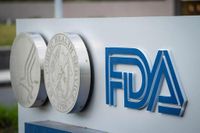As Americans head into the fall of 2025, COVID-19 is once again making headlines, but this time, it’s not just the virus that’s causing concern—it’s the confusion surrounding who can get the latest vaccines and where to find them. With new variants circulating and federal agencies tightening vaccine eligibility, many are left wondering what their options are as cases begin to tick upward across the country.
According to NBC Palm Springs, COVID-19 cases have been rising nationally, a trend confirmed by the Centers for Disease Control and Prevention (CDC). But while the numbers are climbing, they remain notably lower than the surges seen in previous years. The CDC’s most recent variant tracking tool, updated for the period between August 3 and August 30, shows that a new strain, XFG, now accounts for roughly 78 percent of all U.S. cases. This variant, which emerged earlier in 2025, was designated a “variant under monitoring” by the World Health Organization back in late June.
Another variant, NB.1.8.1—previously responsible for rising case numbers in China—has also been making its presence felt in the United States, accounting for 14 percent of cases during the same period. The World Health Organization flagged NB.1.8.1 as a “variant under monitoring” in May, after it fueled a resurgence in China. These two variants now dominate the American COVID-19 landscape, shaping both public health responses and personal anxieties.
Testing data paints a similar picture of gradual but significant change. For the week ending August 23, 2025, 11.2 percent of weekly COVID-19 tests came back positive—a 3.3 percent increase compared to the previous two months, according to CDC figures released on August 31. Hospitalizations, too, have seen an uptick. As of August 9, the rate stood at 1.7 per 100,000 people, about double what it was two years ago. Still, it’s important to keep things in perspective: last year at this time, the rate was 4.3 per 100,000, and in early August 2023, it was 3.3.
Despite these increases, the overall picture is less dire than in previous years. Roughly 200 people have died from COVID-19 each week over the past two months—a sobering figure, but a sharp decline from the more than 1,000 weekly deaths reported in August 2024. According to the CDC, these numbers reflect both the changing nature of the virus and the impact of prior vaccination campaigns, natural immunity, and evolving treatments. CDC wastewater data, which tracks the prevalence of the virus in communities, indicates that most of the country is experiencing “moderate” COVID-19 levels. However, “very high” levels have been reported in several states, including Nevada, Utah, Hawaii, Texas, Nebraska, Louisiana, Alabama, South Carolina, and Washington, D.C.
Against this backdrop, the U.S. Food and Drug Administration (FDA) made a significant announcement on August 27, 2025: updated COVID-19 vaccines from Pfizer, Moderna, and Novavax have been approved, but with tighter restrictions on who can receive them. All seniors are eligible for the new shots, but for younger adults and children, eligibility is now limited to those with at least one high-risk health condition, such as asthma or obesity. The FDA’s decision marks a shift from the broader vaccine access of previous years, reflecting both the lower overall threat posed by current variants and ongoing debates about balancing individual choice, public health, and science.
In a move that’s added to the confusion, the FDA revoked emergency use authorization for Pfizer’s vaccine in children under 5, citing updated risk assessments. Novavax’s shot is now authorized only for those aged 12 and older, and both it and Moderna’s vaccine are subject to the same risk-based restrictions as Pfizer’s. The changes mean that many parents of young children are suddenly left without a vaccine option, a development that’s sparked frustration and uncertainty.
U.S. Health Secretary Robert F. Kennedy addressed the new framework in a social media post last week, writing, “The American people demanded science, safety, and common sense. This framework delivers all three.” He added that the updated shots are “available for all patients who choose them after consulting with their doctors.” Kennedy also announced that the government has pulled remaining authorizations for all other COVID-19 vaccines and convalescent plasma, a therapy used earlier in the pandemic for hospitalized patients before antiviral drugs became widely available.
The ripple effects of these federal decisions have quickly reached local pharmacies. Major chains like CVS and Walgreens have already begun limiting the availability of COVID-19 vaccines, confirming that the FDA’s new guidance has forced them to adjust their policies. For many Americans, this has meant canceled appointments, longer wait times, and a scramble to find out if they or their loved ones are still eligible for a shot. According to CNN, the result is widespread confusion at exactly the moment when clear communication is most needed.
Some health experts and patient advocates argue that the new, narrower eligibility requirements could leave vulnerable groups behind. They point out that while seniors and people with chronic health conditions are rightly prioritized, not all at-risk individuals fit neatly into those categories. Others, however, welcome the move as a sign that the country is entering a new, more manageable phase of the pandemic—one where resources can be more strategically targeted and the risks of unnecessary vaccination are minimized.
Meanwhile, the CDC continues to urge Americans to consult with their healthcare providers about their risk profile and vaccine eligibility. The agency stresses that the best protection against severe illness remains vaccination for those who qualify, along with basic precautions like good hand hygiene and staying home when sick. For those living in states with “very high” levels of COVID-19 in wastewater, extra vigilance is advised, especially for high-risk individuals.
For parents of young children, the sudden loss of vaccine options is particularly tough. Many had hoped that the fall would bring expanded protection as schools reopen and indoor activities resume. Now, they’re left weighing the risks and benefits of sending their kids into group settings without the added layer of vaccine protection. Some are turning to their pediatricians for advice, while others are pressing federal agencies for clearer guidance and a timeline for when new options might become available.
As the country grapples with these changes, one thing is clear: the COVID-19 landscape remains as dynamic as ever. Variants will continue to emerge, policies will evolve, and Americans will have to stay nimble in their response. The hope is that, with science, common sense, and a bit of patience, the nation can navigate this latest chapter with fewer disruptions and more confidence.
For now, Americans are left to sort through the latest round of government guidance, pharmacy restrictions, and shifting eligibility requirements—a process that’s as much about patience as it is about public health.




